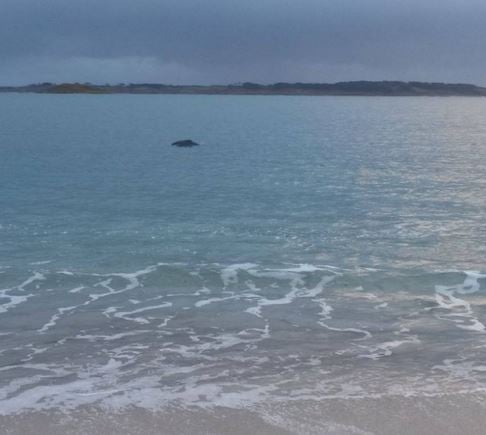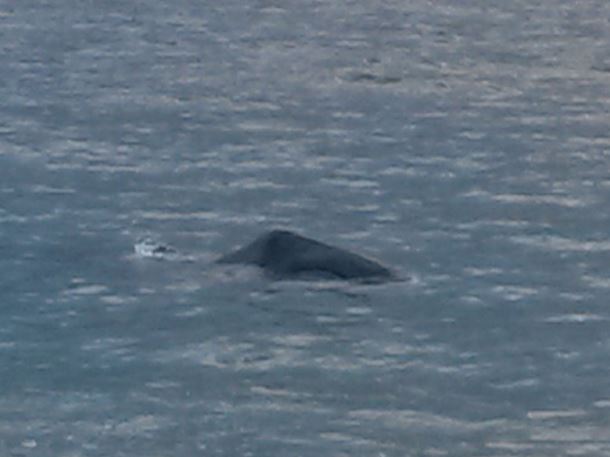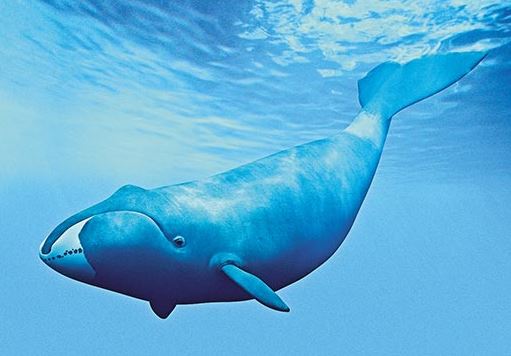Bowhead whales had never been seen off the British coast, that is until professional diver Anna Cawthray saw a young one off the Isles of Scilly while going for a walk with friends on February 20th. She immediately took some pictures of it.
The young, 25 foot whale was just a few metres off Par Beach on the island of St. Martin’s. Ms. Cawthray took the photographs using her friend’s mobile phone.
Ms. Cawthray said:
“It was incredible seeing a whale so close to shore. We were worried it could be stranded, but after about 15 minutes it swam away.”
“You tend to see a lot of dolphins and porpoises on the Isles of Scilly but this was very special. It was a once in a lifetime experience.”

The mystery bowhead whale, just a few metres from the beach. (Image: Sea Watch Foundation)
Ms. Cawthray forwarded the photographs to the Sea Watch Foundation, a national marine environmental charity.
Taking photos on a mobile phone makes it challenging to identify sea creatures. The first picture (above) shows a distant, curved back with no apparent dorsal fin, which made her and some local naturalists think it was a sperm whale.
Sea Watch Foundation’s Founder and Director, Dr Peter Evans, said:
“The images were indeed a challenge. Even with enlarging them, and trying to sharpen them up within Adobe Photoshop, it was very hard to pick out the more subtle features due to the low resolution of the pictures, or even to tell exactly what part of the body was showing in some of the photos.”
“One image, however, showed the animal closer than the rest, and revealed the shape of the head and even the jaw-line.”
Looking more carefully at the close up and the shape of the head and jaw-line, Dr. Evans was eventually able to rule out a sperm whale. He sent the photos to specialists in the United States who identified it as a bowhead whale (Balaena mysticetus), a stocky, dark coloured whale with no dorsal fin that can grow up to 66 feet (20 metres) in length.

The head of the whale. (Image: Sea Watch Foundation)
First sighting in British waters
This incredible sighting, the first of this species in the British Isles, has never been recorded elsewhere in Europe south of the Barents Sea.
Bowheads live in the high arctic and are hardly ever seen beyond 2000 miles north of the UK.
Dr Evans said:
“Bowhead whales are unusual amongst whale species in being largely confined to the coldest parts of the world, generally never far from the ice edge. So to appear this far south may seem enigmatic, particularly when seas are warming, thus encouraging species to extend their ranges further north.”
About bowhead whales
Females and males reach about 20 metres and 18 metres in length respectively, and can weigh as much as 90 tonnes.

The bowhead whale (Balaena mysticetus) is a species of the right whale family Balaenidae. It spends its entire life in and around Arctic waters.
Their heads make up about 40% of body length. Their bodies are very rotund (plump). They have no dorsal fin but a slight dorsal hump in the middle of a smooth back.
They are typically dark in colour, except for the tip of the lower jaw, which is pale.
With a lifespan of between 100 and 200 years, bowhead whales are thought to be the longest-lived of all marine mammals. They reach sexual maturity when they are about 20 years old.
